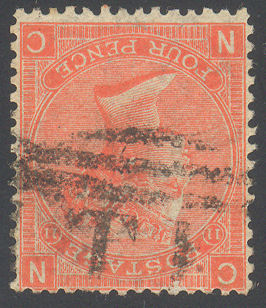
Precancels of Great Britain
This part of the web site is to consolidate information on GB precancels.
The site has expanded. Click here for a site-map.

This appears to be ENT.O.1 (thankfully it was not cut-to-shape). It looks like there was probably nothing before the 'E' and the T.O.1 obliteration had quite a space between the 'O' and the '1'. I have attempted to give my interpretation of what the complete cancel might look like.
Unlike the T.O. series, I have not been able to find any references to this marking at all, it's as if it never existed!
So what does ENT.O. stand for? Answers on the back of a postcard or better still send me an email.
The embossed date-plugs read 10/6/63 which is earlier than most of the normal T.O. series W. H. Smith & Son embossed that I have.
Since there are no periods between the letters of 'ENT' as there is between the 'T' and the 'O', this could be taken to mean that 'ENT' is the first three letters of a word which would simplify things 'Entry', 'Exit'? I note Enteros: (Spanish) meaning, postal stationery with impressed stamps. If this is the case though, it wouldn't work for the T.O. series. Maybe the ENT.O.1 and T.O. series obliterations have nothing to do with each other and the resemblance together with the 'T' to '1' spacing and usage on WHS wrappers is entirely coincidental!
The 'E' could stand for Early, Evening, Eastern or European, but could equally well stand for Exeter, Euston or Edinburgh.
'N' could stand for Night, Newspaper or National, but there have been suggestions that the T.O. series, or at least some of them may have had a connection to the Navy, so perhaps the 'N' stands for Navy or Naval.
'T' could perhaps stand for Tender, Travelling, Temporary, Transit or Territories, but Transit seems to match the evidence best.
Leaving the 'O' standing for Office or Obliterator or something else.
So 'ENT' could stand for 'Early Night Train', 'European Naval Transit', 'Eastern Naval Territories' or, perhaps 'Edinburgh Night Tender' or any number of other things. At the moment it is just a guessing game, but whatever it was, there was seemingly a need to number them.
If 'ENT' means 'Early Night Train', or perhaps 'Early Night Tender', it does at least give a valid reason for the 'T.O.' series starting with 'T'.
The 'O' might stand for 'Office' or perhaps 'Official'.
If we assume that it's related to the T.O. series and that in those the T.O. stands fot Transit Office, then what does the EN stand for ?
The T.O.1 to T.O.6 cancels seem to correlate with Dover, Liverpool, Queenstown, Plymouth, Hull and Southampton.
Perhaps this was Edinburgh Transit Office.

This looks like 'T1' or perhaps 'T.1', symmetry would seem to preclude 'T.L.'.
But the only 'normal' type I can find would be Turnham Green as shown below:
According to Westley (Left illustration), numbers 1, 2 & 3 were sent to Turnham Green on 26/1/74 followed by number 43 of the provincial series on 3/2/74. Billig's Handbook gives the right-hand illustration. These 'T1' cancellations though were in a vertical format whilst the 'T1' above would seem to be in the earlier horizontal format, similar to the T.O. series though a bit larger. The previous owner thought that this was a 'used abroad' item, but the series never got above 'L05' so that cannot be the case. The plate 11 fourpenny stamp used here started production late 1868, plate 12 was put to press 21/3/70.
This may well have nothing to do with precancels, but I include it here simply because of the similarity with the numbering of the T.O. series (which also now has been found to have nothing to do with precancels) and because I have no explanations for it (Explanations invited).
Last updated 12th. October 2021
©Copyright Steve Panting 2010-21 except where stated.
Permission is hereby granted to copy material for which the copyright is owned by myself, on condition that any data is not altered and this website is given credit.